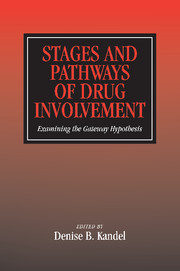Book contents
- Frontmatter
- Contents
- List of Contributors
- Foreword
- Preface
- Part I Overview
- Part II Recent Substantive Findings: What Do We Know About Stages of Drug Use, Risks, and Protective Factors?
- Part III Impact of Prevention Interventions: A Test of the Progression Hypothesis
- Part IV Methodological Issues and Approaches: Advantages and Limitations of Alternate Methods
- 9 Log Linear Sequence Analyses: Gender and Racial/Ethnic Differences in Drug Use Progression
- 10 Cigarette Use and Drug Use Progression: Growth Trajectory and Lagged Effect Hypotheses
- 11 Using Latent Transition Analysis to Examine the Gateway Hypothesis
- 12 Stages of Drug Use Progression: A Comparison of Methods, Concepts, and Operationalizations
- Part V Animal Models and Biological Processes: Implications for Drug Progression
- Part VI Conclusion
- Index
12 - Stages of Drug Use Progression: A Comparison of Methods, Concepts, and Operationalizations
Published online by Cambridge University Press: 25 July 2009
- Frontmatter
- Contents
- List of Contributors
- Foreword
- Preface
- Part I Overview
- Part II Recent Substantive Findings: What Do We Know About Stages of Drug Use, Risks, and Protective Factors?
- Part III Impact of Prevention Interventions: A Test of the Progression Hypothesis
- Part IV Methodological Issues and Approaches: Advantages and Limitations of Alternate Methods
- 9 Log Linear Sequence Analyses: Gender and Racial/Ethnic Differences in Drug Use Progression
- 10 Cigarette Use and Drug Use Progression: Growth Trajectory and Lagged Effect Hypotheses
- 11 Using Latent Transition Analysis to Examine the Gateway Hypothesis
- 12 Stages of Drug Use Progression: A Comparison of Methods, Concepts, and Operationalizations
- Part V Animal Models and Biological Processes: Implications for Drug Progression
- Part VI Conclusion
- Index
Summary
The notion of stages of drug use progression implies two conditions: (1) sequencing, that is, regularities in the sequential patterns of progression that are reflected in partially ordered discrete states, namely stages, and (2) association, that is, stages that are significant indicators of greater risk of progression into higher stages than the risk from any lower stage. As was noted earlier, association implies causation, when nonspuriousness has been definitely established. However, control for all spurious factors cannot be easily implemented. Although the presence of such stages would make it easier to identify individuals who are at greater risk than others for a particular kind of drug use, and thereby to design more effective intervention programs, researchers do not always agree about which conceptualization of stages is the most meaningful and what the stages are. In order to clarify the important relationship between the conceptualization of stages and their operationalization through various methods and models, this chapter discusses three methodological approaches to the study of drug use progression, and the testing of the Gateway Hypothesis in particular, that are analyzed in the present volume: structural equation models with latent variables and linear growth curve models, discussed by Bentler, Newcomb, and Zimmerman in Chapter 10 (Huba, Wingard, & Bentler, 1981; Newcomb and Bentler, 1986a, 1986b); latent transition analysis, (LTA) discussed by Collins in Chapter 11 (Graham, Collins, Wugalter, Chuny, & Hansen, 1991; Collins, 1991; Collins et al., 1994a, 1994b; Collins & Wugalter, 1992); and log linear quasi-independence models, models for parametric event sequence analysis, and hazard rate models for the analysis of drug use initiation, discussed by Yamaguchi and Kandel in Chapters 4 and 9 (Kandel & Yamaguchi, 1993; Yamaguchi & Kandel, 1984a, 1984b, 1997).
Information
- Type
- Chapter
- Information
- Stages and Pathways of Drug InvolvementExamining the Gateway Hypothesis, pp. 270 - 286Publisher: Cambridge University PressPrint publication year: 2002
Accessibility standard: Unknown
- 5
- Cited by
